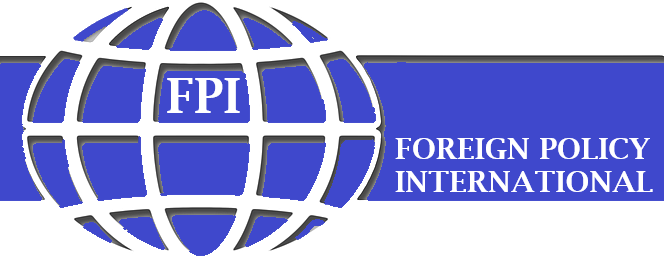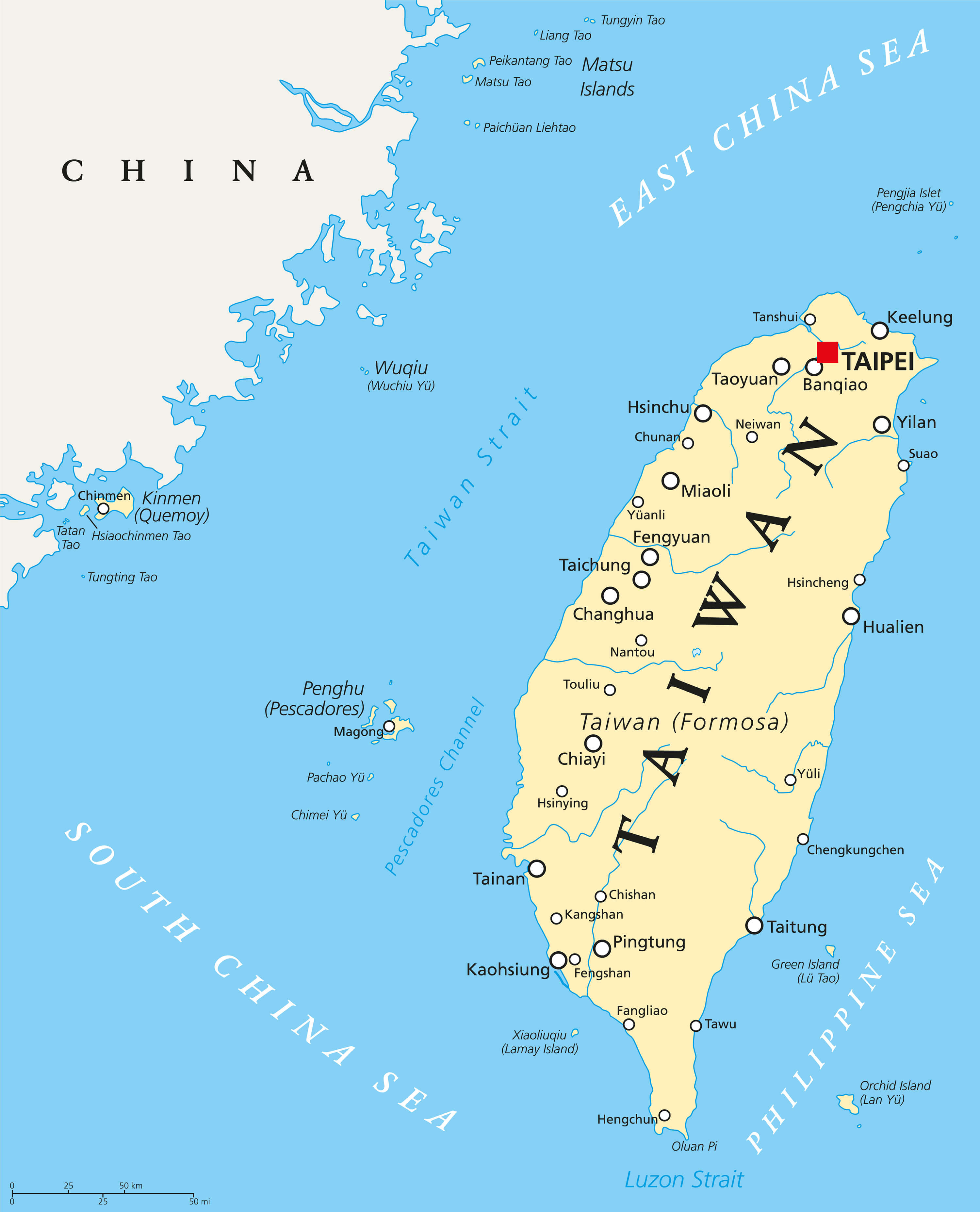Ursache dieses Artikels ist ein Telegram- Eintrag eines Ukraine- Politikers, nachdem China keinen Anspruch auf Taiwan hätte – bezogen auf diesen Artikel im National Interest vom Herbst 2022 – hier der Link / Link in Langschrift:
https://nationalinterest.org/feature/china-has-no-legal-claim-taiwan-205190
Nach dem Lesen dieses Artikels – den FPI davor nicht kannte – wird FPI langsam klar, warum die Welt im EU- und vor allem deutsch- sprachigen Raum bezüglich Taiwan so „seltsam“ ist.
Wahnwelt in Progress – oder Folie a deux für Fortgeschrittene – wird hier seit Jahren gelebt.
+++ +++ +++
Was die USA in diesem Artikel sehr genau herausarbeiten – und auch z. B. Deutschland (2+4-Vertrag) und Österreich (Staatsvertrag) betrifft – ist die strikte Aufteilung von Territorial Sovereignty und Statehood.
Aussagekräftig und interessant dahingehend Abhandlungen wie z. B. diese: STATEHOOD AND TERRITORIAL SOVEREIGNTY: THE TRADITION OF CONCRETENESS AND REALISM (in Google zu finden)
Y
Es gibt dazu zahlreiche weitere Abhandlungen, die es lohnt, zumindest in Ansätzen durchzuarbeiten – sic!
Hier sollten sich Rechts- Interessierte genau informieren – DENN genau das betrifft Österreich und Deutschland im Rahmen ihrer Verträge. Sie haben wohl die eigene Staatlichkeit erhalten – NICHT aber die „Territorial Souvereignty“ über ihr Staatsgebiet – sic!
Y
Viele Rechtsgelehrte halten beides – Statehood und Territorial Sovereignty – für eine untrennbare Einheit – das ist aber falsch. Alleinig die Existenz von Botschaften auf Staatsgebieten – die exterritorial sind – zeigt, mit welcher Akribie diese Aufteilung zu betrachten ist.
Taiwan-USA: Das Statehood liegt klar bei China – was die USA nicht bestreiten. Die Territoriale Souveränität jedoch, so die USA – liegen bei den USA – sic!
Y
Irgendwie – so legt der Artikel dar – sei Taiwan rechtlich den USA unterstellt, und habe irgendwie einen Status wie Puerto Rico (oder so ähnlich).
Bevor sie hier weiterlesen, empfiehlt FPI den obigen Artikel zu lesen – und erst dann hier weiter zu lesen (das ist zum Verständnis des nachfolgenden Artikeltextes besser).
+++ +++
+++ +++ +++
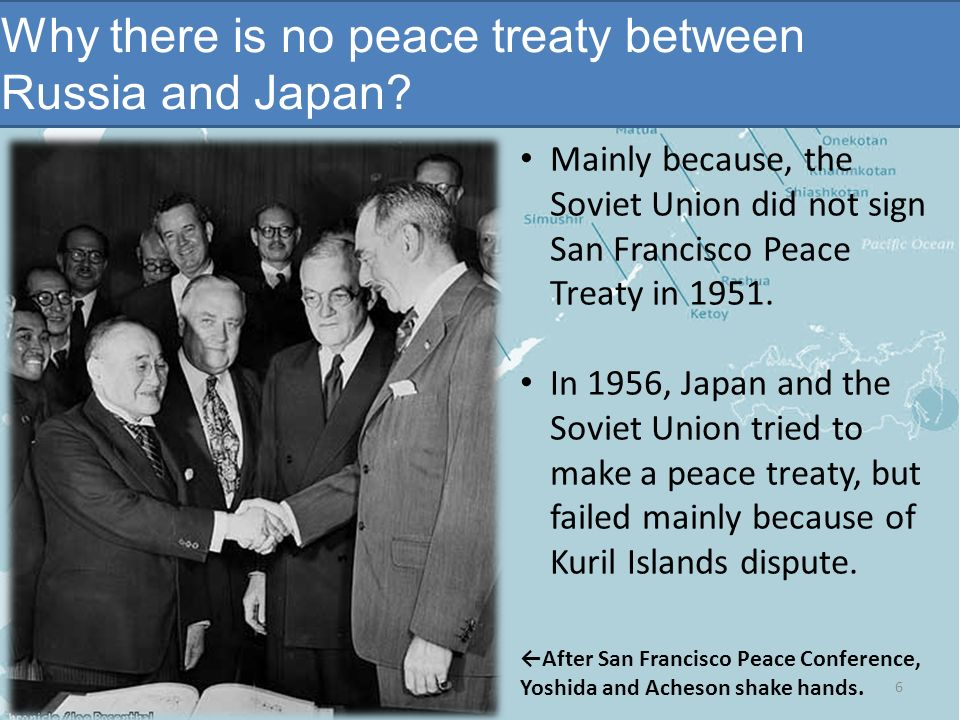
Der Treaty of San Francisco vom 8. September 1951 / in Kraft seit 28. April 1952
Link – Link in Langschrift:
https://www.state.gov/treaty-of-peace-with-japan-san-francisco
Man beachte: Beim Treaty von San Francisco am 28. April 1952 / zwischen USA, anderen Kriegsgegnern und Japan / waren weder die Republik China noch die Volks- Republik China eingeladen / bzw. anwesend.
China was not invited due to disagreements between the United States and Great Britain on whether the established but defeated Republic of China (in Taiwan) or the newly formed People’s Republic of China (in mainland China) represented the Chinese people. The United States recognized the ROC government while Britain had recognized the PRC in 1950. Additionally, an internal US political debate had seen the Republican Party and US military supporting the Kuomintang party and accusing President Truman of having abandoned the anti-communism cause.
Y
Dieser Friedensvertrag ist auch nicht allseits anerkannt – nur eine Minderheit erkennt diesen an – die Länder sind:
Of the 51 participating countries, 48 signed the treaty; Czechoslovakia, Poland and the Soviet Union refused (=Russland als Rechts- Nachfolger der Sowjet- Union).
The signatories to the treaty were: Argentina, Australia, Belgium, Bolivia, Brazil, Cambodia, Canada, Ceylon (currently Sri Lanka), Chile, Colombia, Costa Rica, Cuba, the Dominican Republic, Ecuador, Egypt, El Salvador, Ethiopia, France, Greece, Guatemala, Haiti, Honduras, Indonesia, Iran, Iraq, Laos, Lebanon, Liberia, Luxembourg, Mexico, the Netherlands, New Zealand, Nicaragua, Norway, Pakistan, Panama, Paraguay, Peru, the Philippines, Saudi Arabia, South Africa, South Vietnam, Syria, Turkey, the United Kingdom, the United States, Uruguay, Venezuela and Japan.
The Philippines ratified the San Francisco Treaty on July 16, 1956, after the signing of a reparations agreement between both countries in May of that year. Indonesia did not ratify the San Francisco Peace Treaty. Instead, it signed with Japan a bilateral reparations agreement and peace treaty on January 20, 1958.
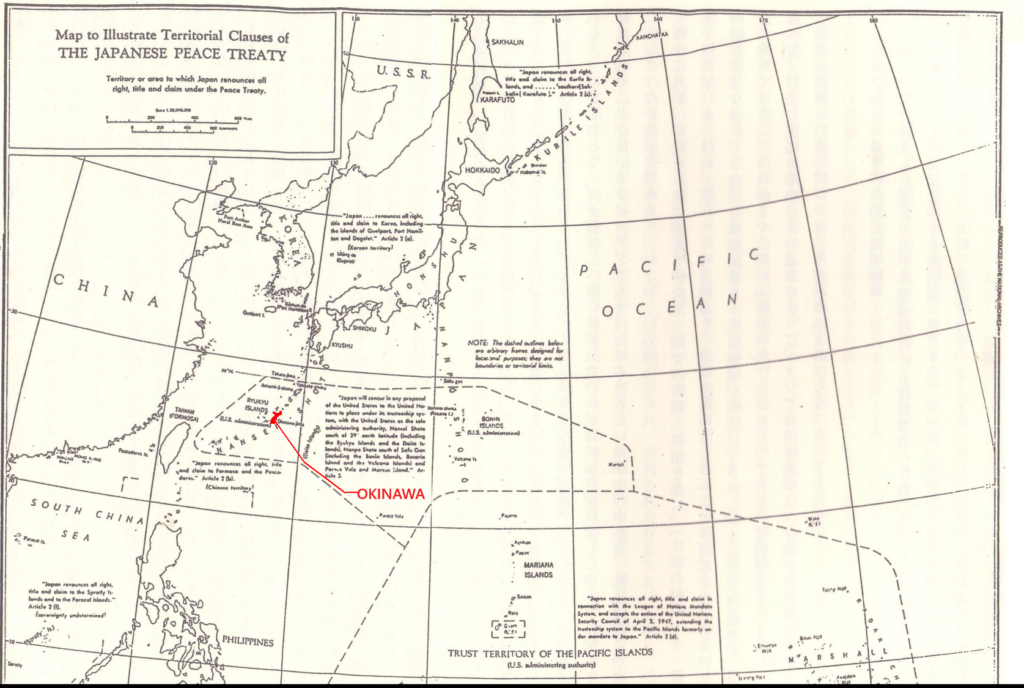
Bild: Man beachte, Taiwan ist hier in dieser zeitgenössischen US- Karte NICHT als US- Trust- Gebiet ausgewiesen – sondern als China- Gebiet – sic!
Unseriöser Weise, haben die USA den Rechtszustand, der für den Nansei-Shot gilt / und in der Karte auch korrekt eingetragen ist / eine Insel des Nansei-Shot ist im Übrigen Okinawa / haben also die USA diesen Rechtszustand – unkorrekt / unrechtmäßig – auf Taiwan ausgedehnt – sic!
+++ +++ +++
Man beachte weiter – im Treaty of San Francisco – verzichtet Japan auch auf alle Kurilen- Ansprüche – sic!
Artikel 2 des Treaty of San Francisco:
https://treaties.un.org/doc/publication/unts/volume%20136/volume-136-i-1832-english.pdf
CHAPTER II
TERRITORY
Article 2
(a) Japan, recognizing the independence of Korea, renounces all right, title and claim to Korea, including the islands of Quelpart, Port Hamilton and Dagelet.
(b) Japan renounces all right, title and claim to Formosa and the Pescadores.
(c) Japan renounces all right, title and claim to the Kurile Islands, and to that portion of Sakhalin and the islands adjacent to it over which Japan acquired sovereignty as a consequence of the Treaty of Portsmouth of September 5, 1905.
(d) Japan renounces all right, title and claim in connection with the League of Nations Mandate System, and accepts the action of the United Nations Security Council of April 2, 1947, extending the trusteeship system to the Pacific Islands formerly under mandate to Japan.
(e) Japan renounces all claim to any right or title to or interest in connection with any part of the Antarctic area, whether deriving from the activities of Japanese nationals or otherwise.
(f) Japan renounces all right, title and claim to the Spratly Islands and to the Paracel Islands.
+++ +++
Zur Beachtung: Der Treaty of Taipeh wurde ein paar Stunden VOR in Kraft- treten des Treaty of San Francisco unterzeichnet / in Kraft gesetzt:
A separate treaty, the Treaty of Taipei, formally known as th Sino-Japanese Peace Treaty, was signed in Taipei on April 28, 1952, between Japan and the ROC, just hours before the Treaty of San Francisco also went into effect on April 28. The apparent illogical order of the two treaties is due to the difference between time zones.
+++ +++ Im Rahmen dieses Treaty verzichtet Japan auf verschiedene Inseln / Gebiete, die es erobert hatte / bzw. in Kriegs- Ergebnis- Abtretungen unter seine Herrschaft brachte – u. a. auch die Insel Formosa / das was heute als Taiwan bekannt ist.
Y
Die USA – in Ignoranz des Treaty of Taipeh (unterzeichnet am selben Tag – aber einige Stunden BEVOR der Treaty of San Francisco rechtsgültig wurde – der für China im Rahmen von Artikel 4 des Taipeh- Vertrages ganz andere Rechts- Zustände fixierte) also diese USA fixierten nun, diese Inseln, auf die Japan verzichtet hatte, seien nun „herrenlos“ – und die USA fixierte einseitig, dass diese Inseln nun US- Protektorate im Rahmen der UN- Charta seien.
Y
Genau das wird im Artikel im National Interest genau so dargestellt.
Y
Irgendwie – so legt der Artikel dar – sei Taiwan rechtlich den USA unterstellt, und habe irgendwie einen Status wie Puerto Rico (oder so ähnlich).
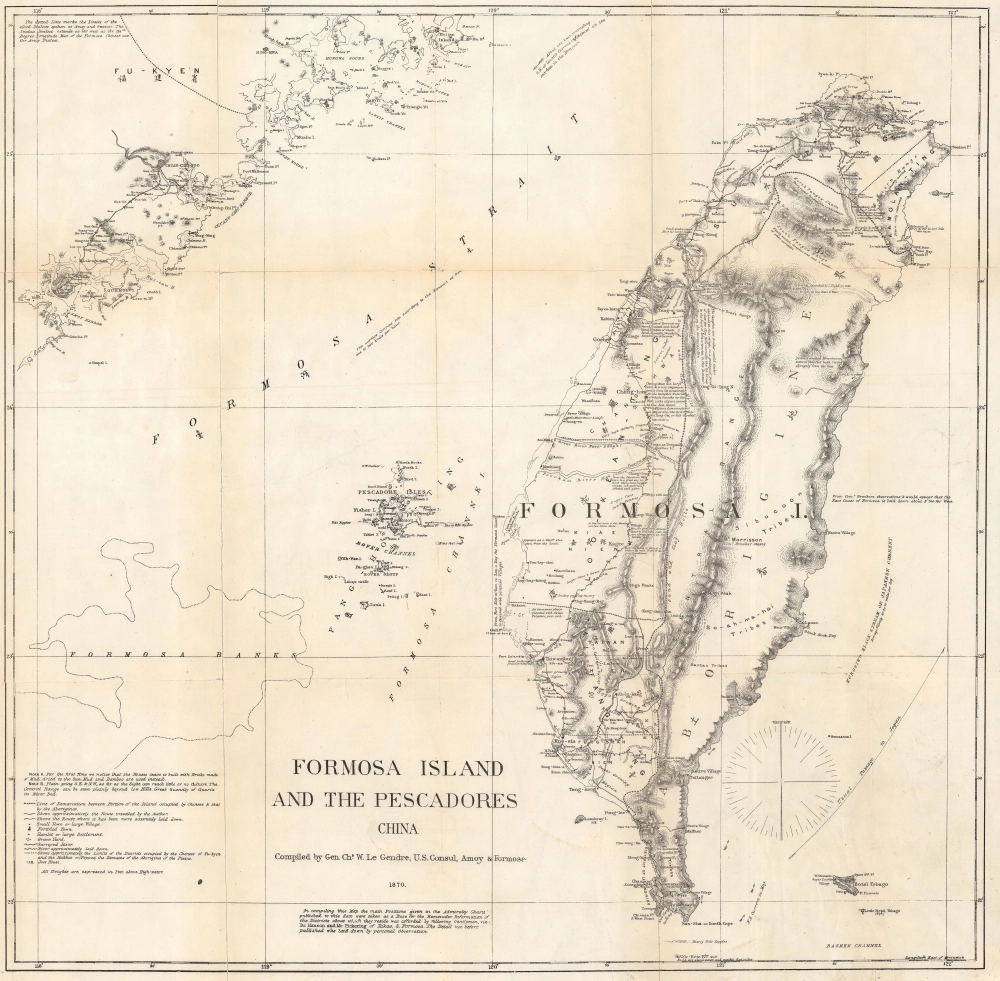
Der China- Machtübergang von 1949:
Chiang moved the government to Taipei, Taiwan, where he resumed his duties as President of the Republic of China on 1 March 1950.[129] Chiang was reelected by the National Assembly to be the President of the Republic of China (ROC) on 20 May 1954, and again in 1960, 1966, and 1972. He continued to claim sovereignty over all of China, including the territories held by his government and the People’s Republic, as well as territory the latter ceded to foreign governments, such as Tuva and Outer Mongolia. In the context of the Cold War, most of the Western world recognized this position and the ROC represented China in the United Nations and other international organizations until the 1970s.
As a result of the surrender and occupation of Japan at the end of World War II, the islands of Taiwan and Penghu were placed under the governance of the Republic of China (ROC), ruled by the Kuomintang (KMT), on 25 October 1945. Following the February 28 massacre in 1947, martial law was declared in 1949 by the Governor of Taiwan Province, Chen Cheng, and the ROC Ministry of National Defense. Following the end of the Chinese Civil War in 1949, the ROC government retreated from the mainland as the Chinese Communist Party (CCP) proclaimed the establishment of the People’s Republic of China. The KMT retreated to Taiwan and declared Taipei the temporary capital of the ROC. For many years, the ROC and PRC each continued to claim in the diplomatic arena to be the sole legitimate government of „China“. In 1971, the United Nations expelled the ROC and replaced it with the PRC.
Treaty of Taipeh – vom 28. April 1952
Unterschrieben am gleichen Tag – aber Stunden vorher – an dem der Treaty of San Francisco in Kraft getreten ist.
Link / Link in Langschrift:
http://taiwandocuments.org/taipei01.htm
Y
Für Taiwan- Interessierte: FPI empfiehlt allen Interessierten, in der Website „Taiwandocuments“ ein bisschen zu stöbern, interessant, was denn da so alles vorhanden ist.
Der Treaty of Taipeh – vom 28. April 1952 (am selben Tag wie der Treaty of San Francisco)- waren nur China= die Republik China und Japan Vertragsparteien.
Man beachte: Der Vertrag von Taipeh ist ein Vertrag zwischen den beiden Konflikt- Parteien selbst – also China und Japan (beim Vertrag von San Francisco war China nicht mal anwesend – geschweige denn unterschreibend).
Man beachte weitergehend:
Zu diesem Zeitpunkt, saß Taiwan im UN- Sicherheitsrat – als Republik China – UND – als permanentes Mietglied= UN- VETO- Macht (sic!). Erst 1971 – also 19 Jahre später – übernahm die Volksrepublik China diese Position – von Taiwan – und damit auch alle Pflichten – und Rechte (und auch den Vertrag von Taipeh als Vertragspartner) -sic!
Abgesehen von den anderen Vertrags-Punkten ist vor allem der Artikel 4 des Vertrages von Taipeh interessant:
Article 4
It is recognised that all treaties, conventions, and agreements concluded before 9 December 1941 between Japan and China have become null and void as a consequence of the war.
Damit wird im Vertrag von Taipeh – unter anderem – klar definiert, dass die Abtretung von Taiwan im Vertrag von Shimonoseki null und nichtig ist.
Y
Es geht hier um mehrere Verträge, die Japan im Verlauf der 1930er- Jahre / bis 1940 von China – unter Kriegsdruck – abgepresst hat (z. B. den Tanggu-Truce / Manchukuo, etc.).
Japan hatte sogar eine eigene China- Vasallen- Regierung eingesetzt, mit der es auch Verträge schloss. Diese Vasallen- Regierung war weder von Chiang Kai Shek noch von Maos Kommunisten anerkannt.
Wäre dieser Artikel 4 des Taipeh- Vertrages nicht gültig, könnte Japan große Teile Chinas – auf Basis dieser Alt- Verträge (die Artikel 4 außer Kraft setzte) für sich beanspruchen – sic!
Für Interessierte – hier eine Liste von Verträgen die China unter Druck hatte machen müssen (nicht nur Japan / sondern viele Mächte) – hier der Link / Link in Langschrift:
https://www.worldstatesmen.org/China_Foreign_colonies.html
Y
Was man erkennen sollte: Am Artikel 4 des Vertrages von Taipeh hängt nicht nur der Vertrag von Shimonoseki, sondern hängen einige mehr – ein ganzes Konvolut – sic!
Man sieht, am Artikel 4 vom Treaty of Taipeh hängt eine gewaltige Menge an Rechts- Zuständen – sic!
WER hat den Treaty of Taipeh unterzeichnet – nun diese Personen:
YEH KUNG-CHAO, [L.S.]
Minister of Foreign Affairs and Plenipotentiary of the Republic of China
ISAO KAWADA, [L.S.]
Minister of Foreign Affairs and Plenipotentiary of Japan
Als die Volksrepublik China die Staatsvertretung für China übernahm, ging der Vertrag / der Vertrags- Zustand auf die Volksrepublik über / für die Republik China war damit der Vertrag beendet.
Hier die Taipei-Times in einem Artikel über den Vertrag – Link / Link in Langschrift:
https://www.taipeitimes.com/News/feat/archives/2019/08/04/2003719869
+++ +++ +++
Europas umfassende geistige nicht- Existenz:
US braucht nur einen Zettel vorlegen – KEINER in EU / D / Ö überprüft irgendwas – und schon passt das.
Wer waren – bzw. sind die Autoren des NI (National Interest)- Artikels?
The Law Offices of Peter C. Hansen, LLC is a boutique law firm in Washington D.C. specializing in African investment projects, international civil service employment, federal employment, and World Bank sanctions and debarment.
X
Michael Rubin (born 1971) is a senior fellow at the American Enterprise Institute (AEI). He previously worked as an official at the Pentagon, where he dealt with issues relating to the Middle East, and as political adviser to the Coalition Provisional Authority.
Y
Michael Rubin hat im Rahmen der Euro- Intellektuell-innen Kult- Status. Seine Worte gelten als absolut – jedwede in Frage Stellung seiner Darstellungen sind de facto Gotteslästerung.
Vermutlich haben die restlosen total- Völkerrechts- Idiot-innen vom D- und Ö- Außenministerium nicht mal gewusst, dass es den Vertrag von Taipeh gibt – geschweige denn was drin steht.
Was Rubin vorlegt darf man weder hinterfragen noch kontrollieren – und schon gar nicht durch weitergehende Dokumente in Zweifel ziehen / das wäre doch politisch unkorrekt / und eigentlich Gotteslästerung – sic!

Hätten die USA / Rubin / einen Zettel vorgelegt, mit dem Inhalt, die USA hätten einen Vertrag mit Aliens vom Andromeda- Nebel bezüglich Taiwan – EU / D / Ö hätten dies auch geglaubt (Rubin darf nicht in Frage gestellt werden).
Die Demokraten- USA kann diesen größenwahnsinnigen Einfaltspinseln vom EU / D / Ö – Außenamt wirklich ALLES erzählen / vorlegen – ALLES – die glauben ALLES, wenn es nur von den Demokraten aus den USA kommt.
Y
Gerade teilt jemand mit, es kann auch sein, dass der Treaty of Taipeh durch die G7 / im Rahmen der G7-rules-based-world-order außer Kraft gesetzt wurde / also für ungültig erklärt wurde. Ja, das kann auch sein.
Y
Gerade das Ö- Außenamt / das dortige Völkerrechts- Büro, teilt ja u. a. mit, dass die G7 rules based world order alles außer Kraft setzen kann – nunja – soweit zu den juristisch völlig Geistesgestörten des Ö- Außenamtes.

Bild: Eine Frage die sich manche D+Ö- Regierungs- Aktivist-innen stellen sollten -sic!
Appendix
Der (nicht mehr gültige) Vertrag von Shimonoseki / und Rahmen- Infos:
https://china.usc.edu/treaty-shimonoseki-1895
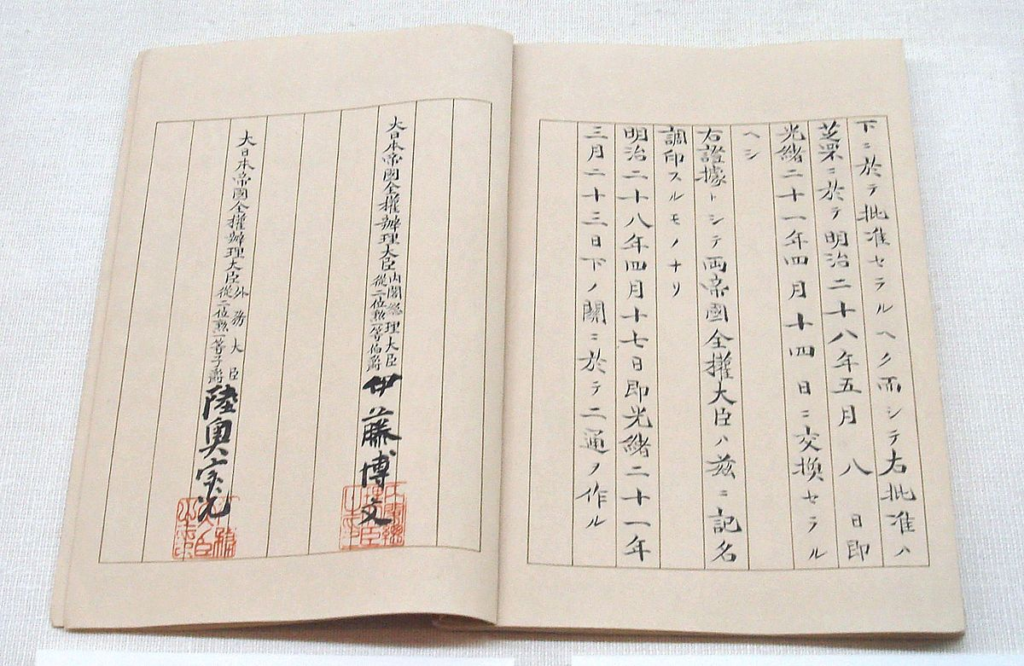
Article 1
China recognises definitively the full and complete independence and autonomy of Korea, and, in consequence, the payment of tribute and the performance of ceremonies and formalities by Korea to China, in derogation of such independence and autonomy, shall wholly cease for the future.
Article 2
China cedes to Japan in perpetuity and full sovereignty the following territories, together with all fortifications, arsenals, and public property thereon:
(a) The southern portion of the province of Fêngtien [Fengtian] within the following boundaries [Liaodong agreement in November 1895 deleted this and replaced it with an indemnity of 30 million taels of silver to be paid Japan]:
The line of demarcation begins at the mouth of the River Yalu and ascends that stream to the mouth of the River An-ping [Anping], from thence the line runs to Fêng-huang [Fenghuang], from thence to Hai-cheng [Haizheng?], from thence to Ying-kow [Yinzhou?], forming a line which describes the southern portion of the territory. The places above named are included in the ceded territory. When the line reaches the River Liao at Ying-kow, it follows the course of the stream to its mouth, where it terminates. The mid-channel of the River Liao shall be taken as the line of demarcation.
This cession also includes all islands appertaining or belonging to the province of Fêngtien situated in the eastern portion of the Bay of Liao-tung and the northern portion of the Yellow Sea.
(b) The island of Formosa, together with all islands appertaining or belonging to the said island of Formosa.
(c) The Pescadores Group, that is to say, all islands lying between the 119th and 120th degrees of longitude east of Greenwich and the 23rd and 24th degrees of north latitude.
Article 3 [deleted by the Liaodong agreement, November 1895]
The alignment of the frontiers described in the preceding Article, and shown on the annexed map, shall be subject to verification and demarcation on the spot by a Joint Commission of Delimitation, consisting of two or more Japanese and two or more Chinese delegates, to be appointed immediately after the exchange of the ratifications of this Act. In case the boundaries laid down in this Act are found to be defective at any point, either on account of topography or in consideration of good administration, it shall also be the duty of the Delimitation Commission to rectify the same.
The Delimitation Commission will enter upon its duties as soon as possible, and will bring its labours to a conclusion within the period of one year after appointment.
The alignments laid down in this Act shall, however, be maintained until the rectifications of the Delimitation Commission, if any are made, shall have received the approval of the Governments of Japan and China.
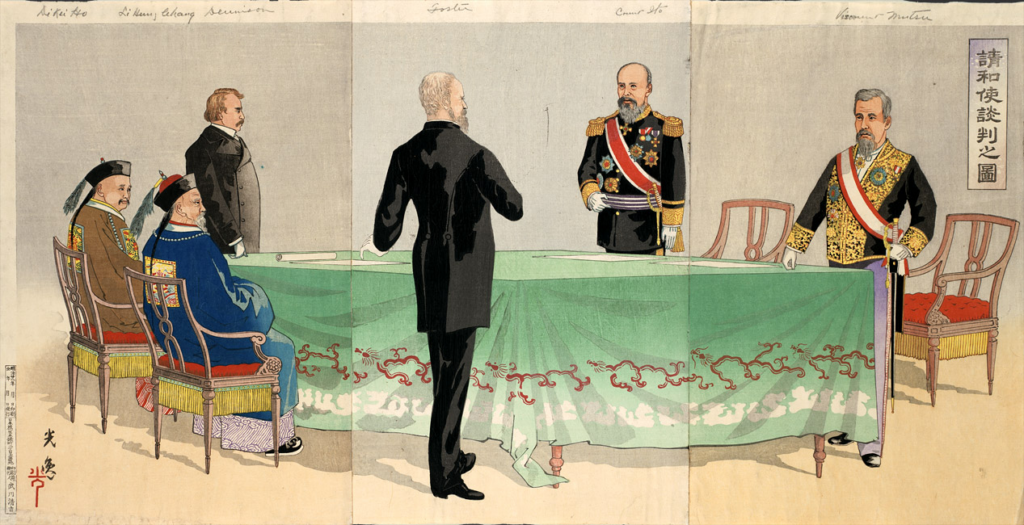
Triple- Intervention wegen des Vertrags von Shimonoseki:
Entry of the Western powers
The conditions imposed by Japan on China led to the Triple Intervention of Russia, France, and Germany, western powers all active in China, with established enclaves and ports, just six days after its signing. They demanded that Japan withdraw its claim on the Liaodong peninsula, concerned that Lüshun, then called Port Arthur by Westerners, would fall under Japanese control. Tsar Nicholas II of Russia (an ally of France) and his imperial advisors, including Kaiser Wilhelm II of Germany, had designs on Port Arthur, which could serve as Russia’s long sought-after ‚ice-free‘ port.
The Japanese government reluctantly acceded to the intervention, as British and American diplomatic intercession was not forthcoming, and Japan was in no position to militarily resist three major European powers simultaneously. The three powers had 38 warships with a displacement of 95,000 tons already deployed in East Asia, whereas the Imperial Japanese Navy had only 31 warships in total with a displacement of 57,000 tons. After futile diplomatic efforts to enlist the support of the United States and Great Britain, on 5 May 1895, Prime Minister Itō Hirobumi announced the withdrawal of Japanese forces from the Liaodong Peninsula in exchange for an additional indemnity of 30 million kuping taels (450 million yen). The last Japanese troops departed in December.
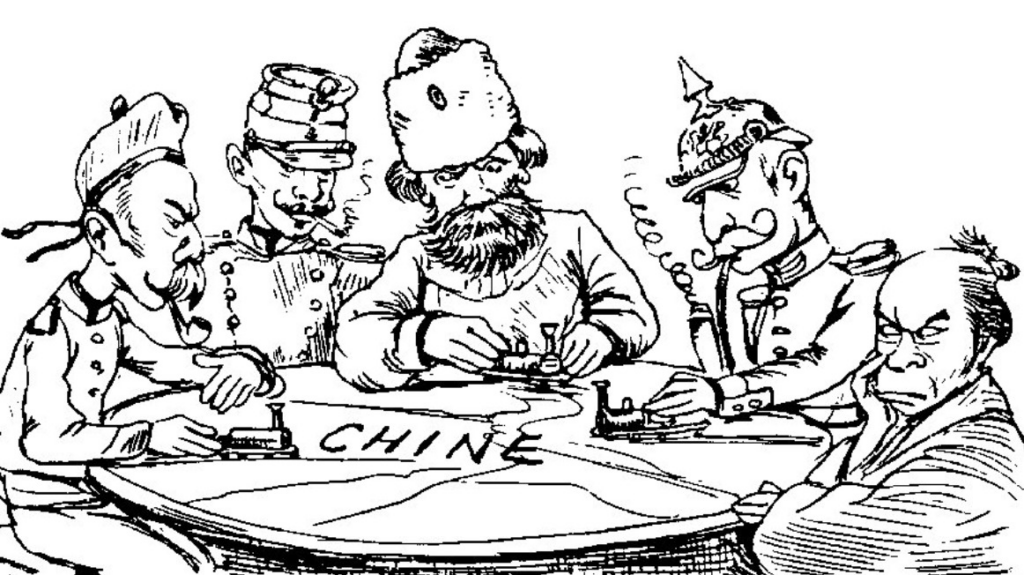
The Triple Intervention had a profound effect on Japanese foreign relations, as Japanese diplomacy sought to avoid a reconstitution of a combination of European Powers against Japan. It led directly to the Anglo-Japanese Alliance of 1902 which was explicitly intended to shield Japan from interference from other European Great Powers, and from Russia in particular.
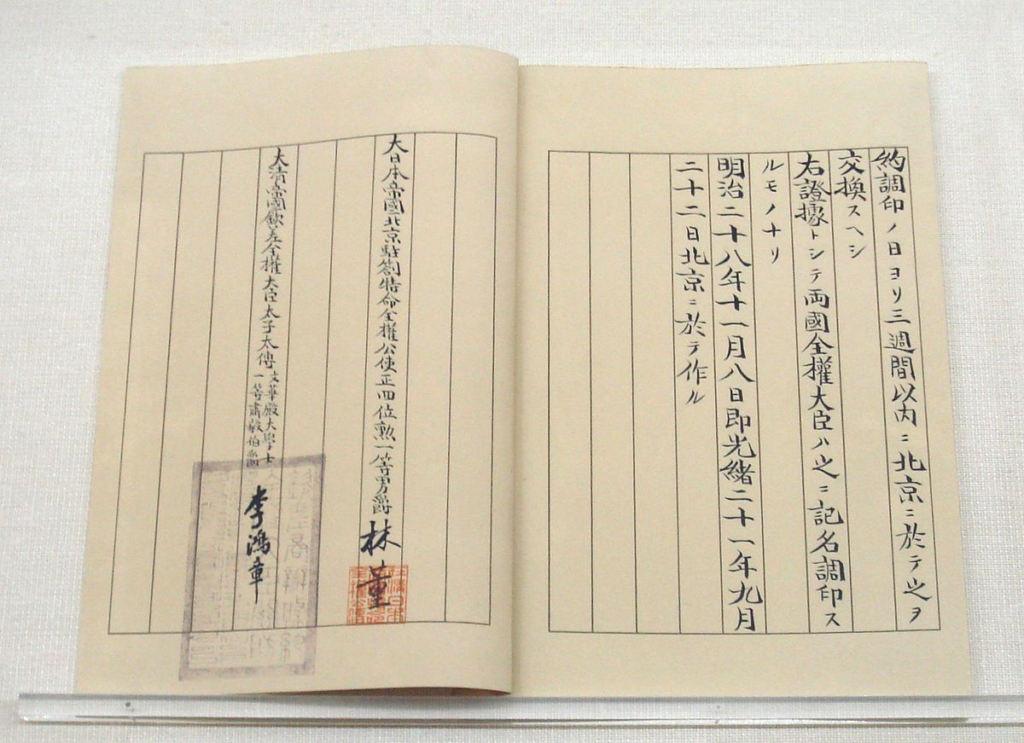
+++ +++ +++
